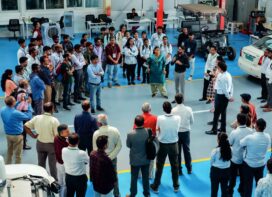 Changes in the personal mobility market present great opportunities for urban mobility players to attract new customers. Car manufacturers and automotive leasing and rental industries are increasingly positioning themselves as providers of mobility services, e.g. by extending their traditional business with car-sharing services. Combining various transport services, e.g. car sharing, ride-hailing, bike- and scooter-sharing, carpooling and demand-responsive transport (not to forget the high-quality and real-time information about walking and cycling options and conditions) can complement classic fixed-route, timetabled public transport. For transport providers, combined mobility and Mobility as a Service schemes offer new sales channels, access to untapped customer demand, advanced user account and payment management, as well as richer data on travel demand patterns and dynamics.
Changes in the personal mobility market present great opportunities for urban mobility players to attract new customers. Car manufacturers and automotive leasing and rental industries are increasingly positioning themselves as providers of mobility services, e.g. by extending their traditional business with car-sharing services. Combining various transport services, e.g. car sharing, ride-hailing, bike- and scooter-sharing, carpooling and demand-responsive transport (not to forget the high-quality and real-time information about walking and cycling options and conditions) can complement classic fixed-route, timetabled public transport. For transport providers, combined mobility and Mobility as a Service schemes offer new sales channels, access to untapped customer demand, advanced user account and payment management, as well as richer data on travel demand patterns and dynamics.
Connectivity, accessibility and affordability are often cited as the main goals of transport policy, supplemented with the requirements of the minimization of the externalities, like accidents, environmental effects and congestion. Mobility as a Service holds the promise to make delivery of these targets more probable than ever before. Enhanced connectivity and digital information services are creating – for the first time ever – real-life preconditions for seamlessly multi-modal transport systems, where the modal shift can be realized. MaaS aims at integrating public and private modes of transport into convenient offerings and combining services, which have competed in the past. Better access and exchange of data will also simplify trip planning and comparison and improve cost transparency.
The MaaS is expected to grow to a business worth over one trillion euro by 2030. All around the world, MaaS initiatives are planned or starting up and the MaaS Alliance helps these to cooperate through a shared work program engaging service providers, transport operators, public authorities and users in order to create a vital and inter-operable MaaS ecosystem to fulfill high expectations. But how to create a thriving MaaS ecosystem? What are the preconditions for the success of MaaS?
Open Ecosystem Approach
In a digital economy, the ownership and access to data determines the market dominance. In order to build real multiplayer, multi-option market platforms, service providers must provide each other access to essential information in a computer-readable format, including routes, timetables, stops, prices and accessibility information. Further on, ticketing and payment system interfaces should be accessible for other service providers. The establishment of an open ecosystem can be encouraged by public procurement rules, requiring interoperability of ticketing and payment systems with other similar systems.
Better access to travel planning data is, however, not sufficient. In order to make seamless multi-modal transport a reality, it is imperative that third parties can establish a secure real-time data-connection to the vehicles in their fleets. Without the ability of mobility operators (apart from the manufacturers) to know what is going on with vehicles at any given point in time, MaaS will fail to materialize as the necessary preconditions.
One of the obstacles for the development of the MaaS ecosystem could be the regulatory uncertainties, creating additional risks for investors and dissuading them to invest in evolving markets. A complex regulatory framework with multiple national and international regulatory layers might hinder the development of new services and cause additional risks for investments. For the development of a MaaS ecosystem and scalability of services, it is pivotal that future regulatory initiatives, both in national and international level, acknowledge the integrated and multi-modal characteristics of MaaS services.
User is playing a centric role
End users are the focus of the ‘service’ in MaaS and all other elements are enablers (i.e. technology, policy, business models, land use and physical design, and legislation). In fact, even “mobility” is an enabler, the end goal being “access” or meeting the needs and aspirations of the user.
Although current travel behavior and mobility patterns can provide insight for MaaS product and system design, one must keep in mind that current behavior is not necessarily the same as possible and/or self-desired behavior, i.e. analyzing historic behavior is not enough when designing MaaS packages. MaaS has the potential to change the choice set.
 TrafficInfraTech Magazine Linking People Places & Progress
TrafficInfraTech Magazine Linking People Places & Progress


